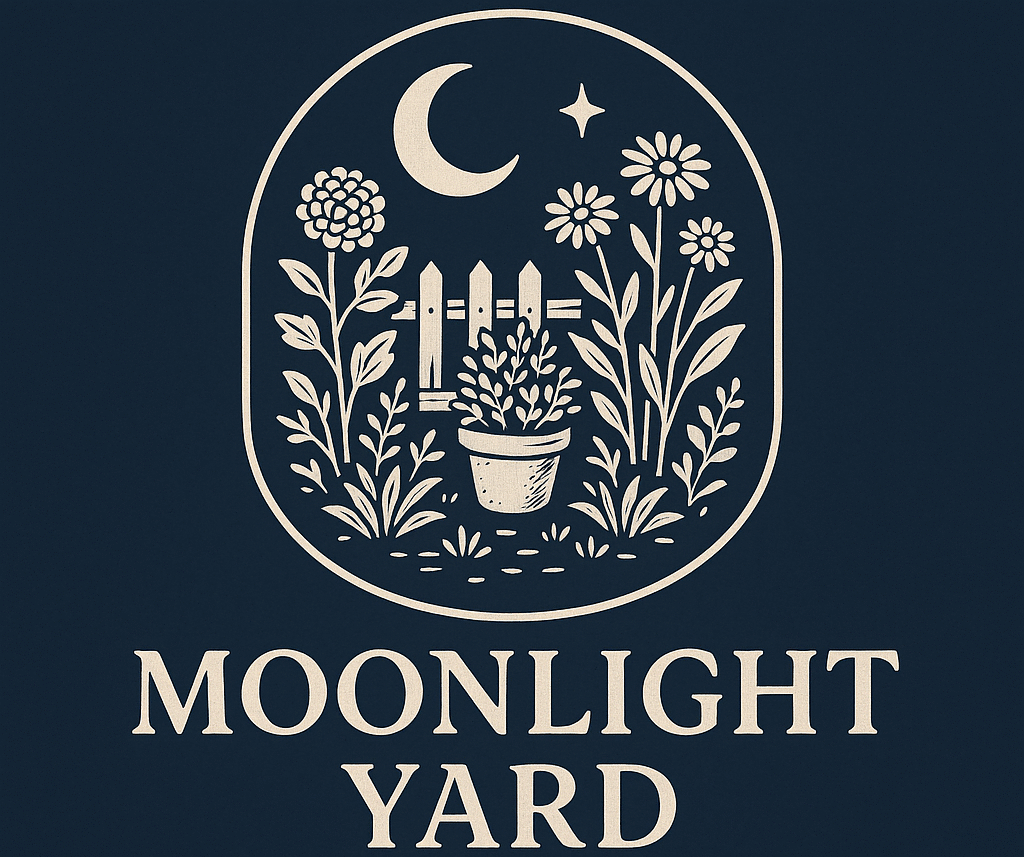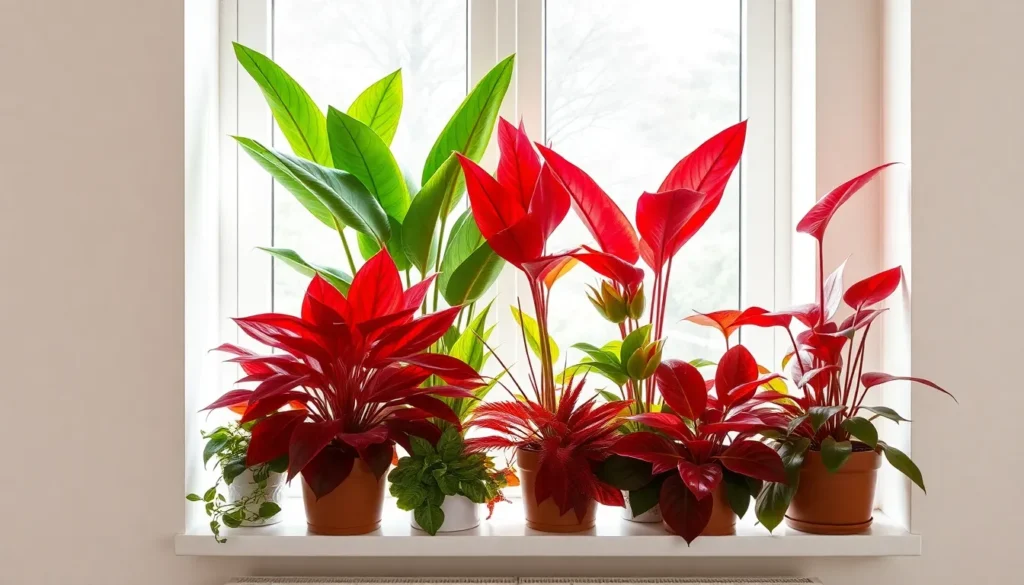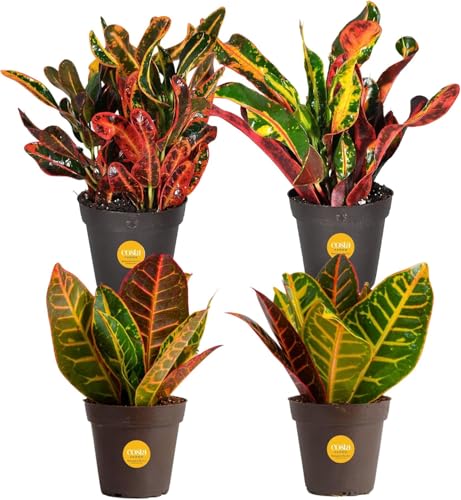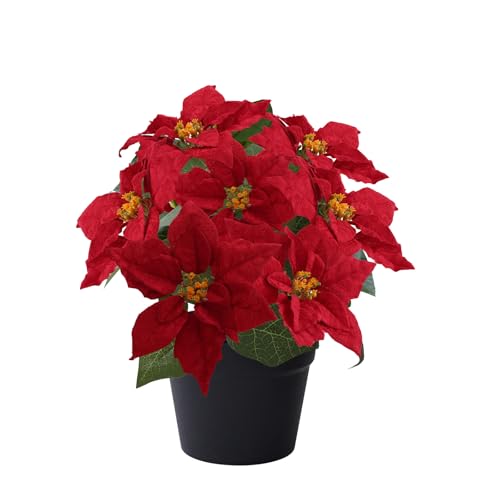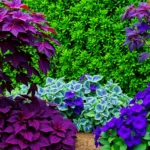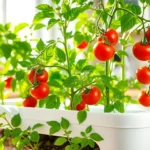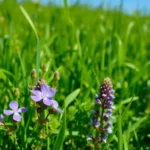Red-leafed houseplants transform any living space into a stunning botanical showcase that captivates guests and brings warmth to even the most neutral interiors. We’ve discovered that these vibrant specimens offer more than just visual appeal – they’re conversation starters that add personality and sophistication to your home décor.
Whether you’re a seasoned plant parent or just beginning your indoor gardening journey, houseplants with red leaves provide the perfect opportunity to create dramatic focal points throughout your space. From deep burgundy foliage to bright crimson accents, these remarkable plants deliver year-round color that traditional flowering houseplants simply can’t match.
We’ll explore the most popular and easy-to-care-for varieties that thrive indoors, along with essential tips for maintaining their brilliant red coloration. You’ll discover how proper lighting, watering techniques, and strategic placement can help your red-leafed beauties flourish while creating the striking visual impact you’re looking for.
Understanding Red-Leafed Houseplants and Their Appeal
Red leafed houseplants captivate us with their extraordinary ability to transform ordinary spaces into vibrant living galleries. These botanical gems produce their stunning crimson, burgundy, and scarlet hues through specialized pigments called anthocyanins, which develop naturally in response to exact environmental conditions.
Color Development Science
Anthocyanin production occurs when plants experience particular light spectrums, temperature fluctuations, or stress factors that trigger pigment synthesis. We’ve observed that many red leafed varieties intensify their coloration during cooler months or when exposed to bright indirect light. Plants like the Red Aglaonema and Coleus develop deeper red tones when they receive consistent lighting conditions between 10-12 hours daily.
Visual Impact Benefits
Red foliage creates dramatic focal points that instantly draw attention and elevate interior design schemes. We find these plants particularly effective in modern minimalist spaces where their bold coloration contrasts beautifully against neutral backgrounds. Living rooms benefit from large red leafed specimens like the Red Rubber Plant, while smaller varieties such as the Ruby Red Caladium work perfectly on desks and tabletops.
Psychological Effects
Research indicates that red colored plants stimulate energy levels and create feelings of warmth and excitement in indoor environments. We notice that homeowners often report feeling more inspired and motivated when surrounded by these vibrant specimens. The rich red tones can make spaces feel more intimate and welcoming, especially during darker winter months when natural light decreases.
Care Considerations
Most red leafed houseplants require exact conditions to maintain their brilliant coloration throughout the year. We recommend monitoring humidity levels between 40-60% and providing consistent temperatures ranging from 65-75°F for optimal pigment development. Proper fertilization with balanced nutrients every 4-6 weeks during growing seasons helps sustain the intense red pigmentation that makes these plants so desirable.
Coleus: The Vibrant Foliage Champion
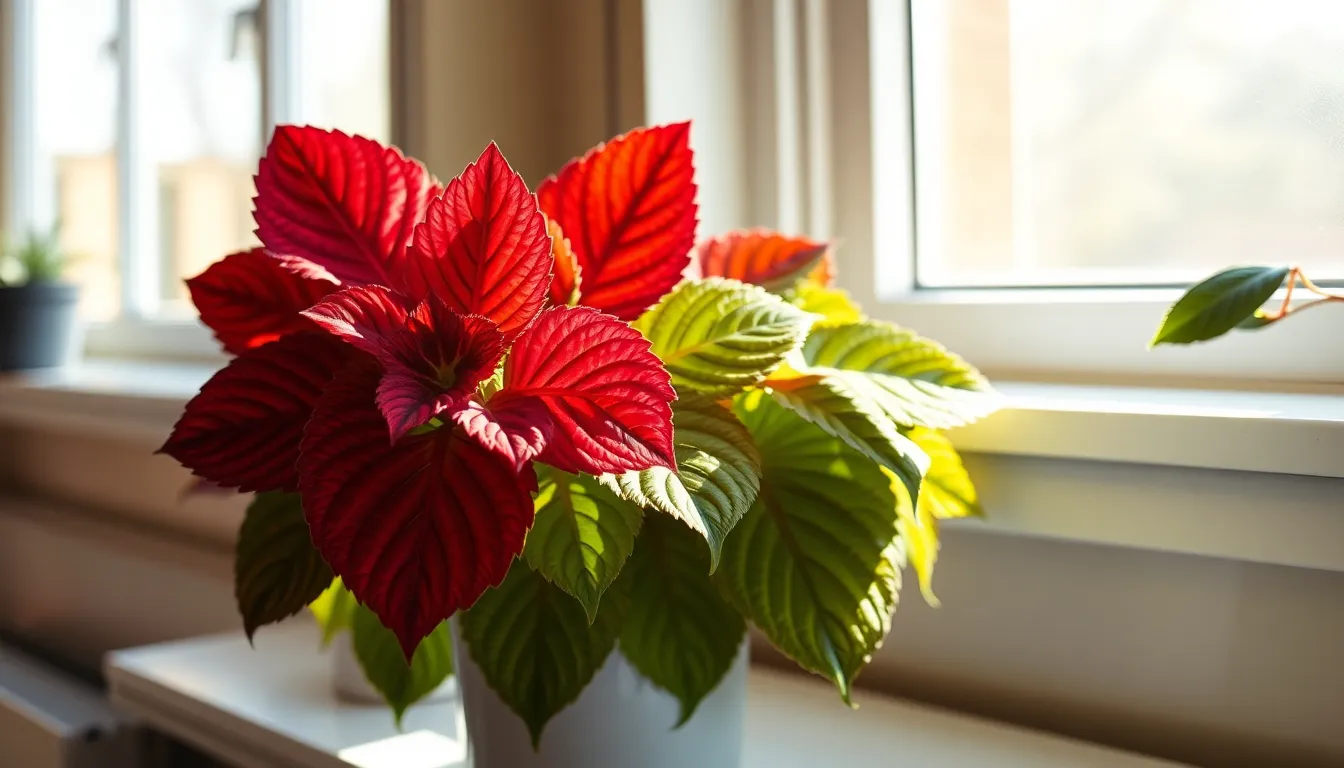
Coleus stands out as one of our favorite red leafed houseplants, offering stunning Plectranthus scutellarioides varieties that transform any indoor space. These remarkable plants showcase large, colorful leaves that blend red, pink, and green hues in breathtaking combinations.
Growing Requirements and Care Tips
Bright, indirect light works best for maintaining coleus’s vibrant red coloration indoors. Position your plant near an east or west-facing window where it’ll receive plenty of illumination without harsh direct rays that can scorch the delicate foliage.
Watering consistency keeps these plants thriving throughout the growing season. We recommend checking the soil moisture regularly and maintaining slightly damp conditions without creating waterlogged roots that lead to rot.
Average room temperatures between 65-75°F provide ideal growing conditions for indoor coleus varieties. Avoid placing plants near heating vents or air conditioning units that create temperature fluctuations.
Regular pruning encourages bushier growth and prevents your coleus from becoming leggy or sparse. Pinch back flower spikes as they appear to redirect energy into producing those gorgeous red leaves we love.
Popular Red Varieties to Consider
Coleus ‘Redhead’ features intense crimson leaves with darker burgundy edges that create stunning contrast. This variety maintains its bold red pigmentation even in lower light conditions compared to other cultivars.
Coleus ‘Red Ruffles’ displays deeply serrated leaf margins with rich scarlet coloring throughout the foliage. The ruffled texture adds visual interest and makes this variety perfect for creating dramatic focal points in plant arrangements.
Coleus ‘Wizard Red’ produces compact growth with solid red leaves that intensify under proper lighting conditions. This dwarf variety works exceptionally well in smaller spaces or as part of mixed container displays.
Coleus ‘Solar Flare’ combines fiery red centers with golden yellow edges that create a striking two-tone effect. The contrasting colors become more pronounced when the plant receives adequate bright light exposure.
Red Aglaonema: The Chinese Evergreen Beauty
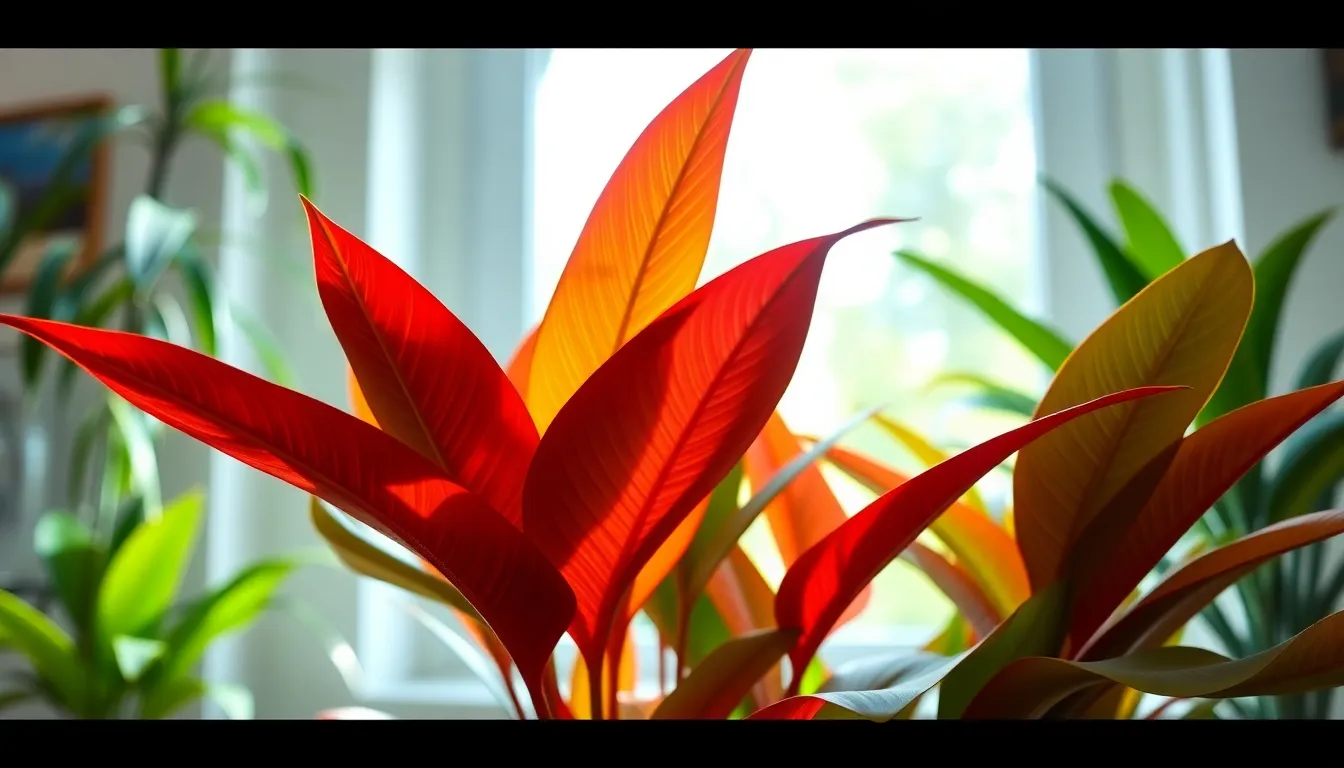
Red Aglaonema stands out as one of the most reliable red-leafed houseplants for beginners and experienced gardeners alike. This stunning Chinese Evergreen variety combines vibrant red foliage with exceptional adaptability to indoor conditions.
Light and Water Preferences
Bright, indirect light creates the perfect environment for Red Aglaonema to develop its most intense coloration. Direct sunlight can scorch the delicate red leaves, while too little light causes the vibrant hues to fade significantly. We recommend placing your plant near an east-facing window or several feet away from a south-facing window for optimal results.
Well-draining soil prevents the root rot issues that commonly affect overwatered Chinese Evergreens. The soil should feel slightly moist but never waterlogged or soggy to the touch. Check the top inch of soil regularly, and water only when this layer feels completely dry.
Consistent watering schedules work better than sporadic deep watering for maintaining healthy Red Aglaonema plants. During growing season, you’ll typically need to water every 7-10 days, while winter months may require watering only every 2-3 weeks. Room temperature water prevents shock to the root system and promotes steady growth.
Propagation and Maintenance
Stem cuttings offer the most reliable propagation method for Red Aglaonema plants throughout the year. Cut 4-6 inch sections from healthy stems, ensuring each cutting includes at least two nodes where roots will develop. Place these cuttings in water or moist potting mix until new root systems establish after 3-4 weeks.
Division works exceptionally well during repotting seasons when your Chinese Evergreen has developed multiple crowns or offshoots. Carefully separate the root ball into sections, making sure each division has its own root system and several healthy stems. This method often produces faster results than stem cuttings.
Regular pruning maintains the compact, bushy shape that makes Red Aglaonema so attractive as an indoor specimen. Remove any yellowing or damaged leaves by cutting them at the base of the stem. Pruning also encourages new growth and helps maintain the plant’s vibrant red coloration.
Balanced fertilization during growing months supports optimal leaf color development in Red Aglaonema varieties. Apply a diluted liquid fertilizer every 4-6 weeks from spring through early fall, then reduce feeding during winter dormancy. Over-fertilization can actually diminish the intensity of red pigmentation, so less is often more with these plants.
Caladium: Heart-Shaped Red Splendor

Caladiums captivate us with their distinctive heart-shaped leaves that showcase brilliant red patterns and markings. These tropical beauties bring an exotic flair to indoor spaces with their papery thin foliage and dramatic color combinations.
Seasonal Care and Dormancy Period
Active growing season requires consistent warmth and humidity to keep caladiums thriving indoors. We maintain temperatures between 70-85°F during spring and summer months when these plants display their most vibrant red coloration.
Watering frequency increases during the growing season as caladiums prefer consistently moist but not waterlogged soil. Regular fertilization every 2-3 weeks with a balanced liquid fertilizer supports healthy leaf development and maintains those stunning red hues.
Dormancy preparation begins in late fall when we gradually reduce watering as temperatures cool. Caladiums naturally enter their dormant phase during winter months, requiring us to store their tubers in a warm, dry location around 60-65°F.
Tuber storage involves carefully removing the bulbs from soil once foliage dies back completely. We clean off excess dirt and store them in peat moss or vermiculite in a dark, well-ventilated area until spring replanting.
Best Red Cultivars for Indoor Growing
‘Red Flash’ displays stunning white leaves with bright red veining and red margins that create striking contrast. This cultivar adapts well to indoor conditions and maintains its vibrant coloration with proper bright, indirect lighting.
‘Candidum’ features predominantly white leaves accented with red speckles and green veining throughout. Indoor growers appreciate this variety’s tolerance for lower light conditions while still producing impressive red markings.
‘Freida Hemple’ showcases deep red leaves with darker red veining that intensifies under optimal growing conditions. We recommend this cultivar for experienced indoor gardeners seeking bold, dramatic red foliage impact.
‘Red Ruffles’ produces ruffled edges on its red leaves with green borders that add textural interest to any indoor plant collection. This variety responds exceptionally well to high humidity environments typical of indoor growing setups.
Croton: The Tropical Show-Stopper

Croton stands out as one of nature’s most vibrant houseplants, displaying spectacular leaves in brilliant shades of red, green, yellow, and orange. This tropical beauty brings exotic flair to any indoor space with its stunning variegated foliage.
Temperature and Humidity Needs
Temperature control plays a crucial role in maintaining your croton’s health and vibrant coloration. We recommend keeping your plant in temperatures between 65°F and 75°F (18°C to 24°C) for optimal growth. Cold drafts and sudden temperature drops can stress the plant and cause leaf drop, so position it away from windows, doors, and air conditioning vents.
Humidity levels significantly impact your croton’s overall well-being and leaf quality. While these plants can tolerate average home humidity, they’ll thrive with levels above 50%. Consider placing a humidifier nearby or setting your pot on a pebble tray filled with water to increase local humidity. Grouping your croton with other tropical plants also creates a naturally humid microenvironment.
Monitor your plant’s response to environmental changes by watching for leaf browning or dropping. Consistent temperatures and adequate humidity will reward you with the most vibrant red and multicolored foliage that makes crotons so desirable.
Pruning and Shaping Techniques
Regular pruning keeps your croton healthy and maintains its attractive, compact shape. Remove dead, damaged, or yellowing leaves immediately to prevent disease and redirect energy to healthy growth. Use clean, sharp pruning shears to make clean cuts just above a leaf node or branch junction.
Shaping your croton requires strategic trimming to encourage bushier growth and prevent legginess. Pinch or cut the growing tips when the plant reaches your desired height to promote lateral branching. This technique creates a fuller, more attractive plant with denser foliage.
Timing your pruning sessions during the growing season yields the best results for new growth development. Spring and early summer provide optimal conditions for recovery and vigorous regrowth. Always wear gloves when pruning, as croton sap can cause skin irritation in sensitive individuals.
Weekly inspections help you identify pruning opportunities before problems develop. Fresh cuts heal quickly in proper growing conditions, and your croton will respond with renewed growth and even more spectacular red leaf coloration.
Red-Leaf Begonia: Delicate and Striking
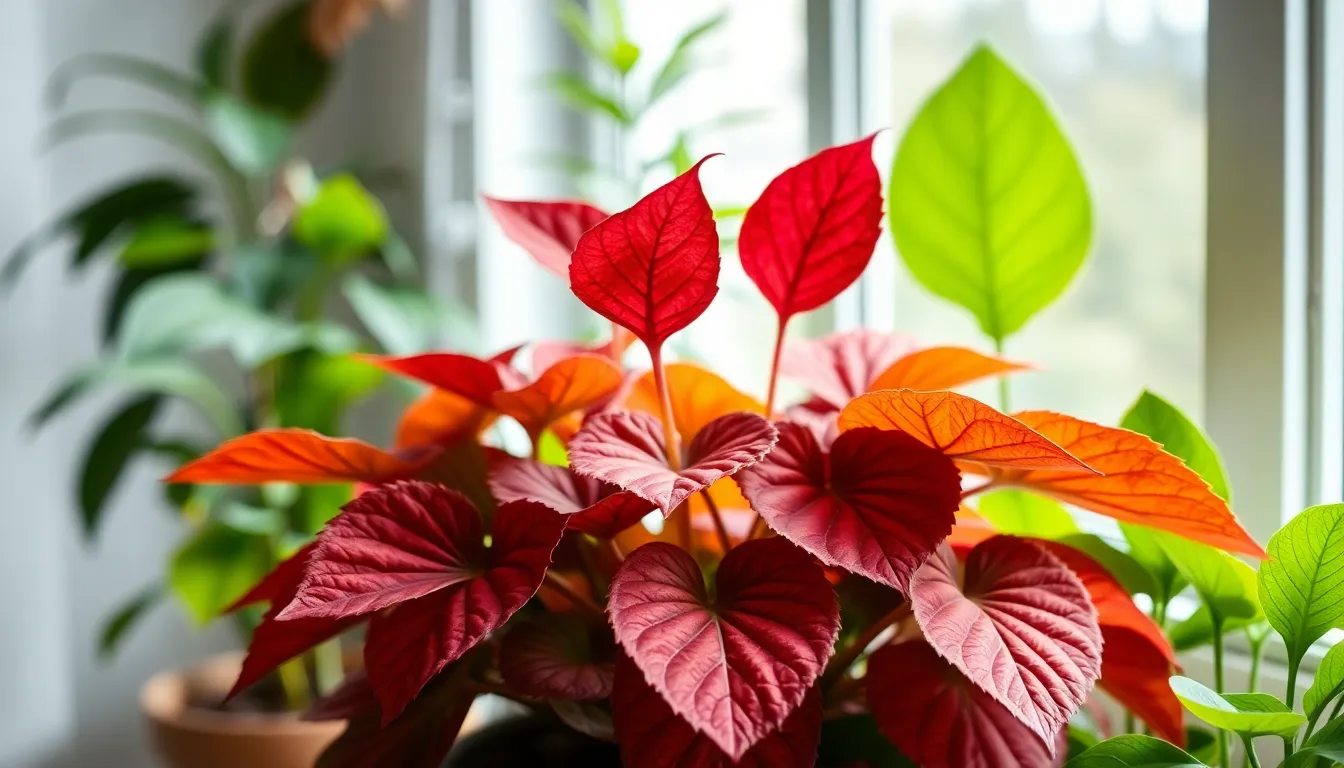
Red leaf begonias bring extraordinary elegance to indoor spaces with their delicate texture and vibrant coloration. Their striking red foliage creates stunning visual contrast against traditional green houseplants.
Soil Requirements and Fertilizing
Well draining soil forms the foundation for healthy red leaf begonia growth. We recommend using a high quality potting mix that allows excess water to flow freely while retaining essential moisture for the roots. Adding perlite or coarse sand to standard potting soil improves drainage and prevents waterlogged conditions that can damage these delicate plants.
Fertilizing red leaf begonias requires regular attention during their active growing season. We apply a balanced liquid fertilizer every two weeks from spring through early fall to maintain vibrant leaf coloration and promote healthy growth. Diluting the fertilizer to half strength prevents root burn while providing necessary nutrients for optimal development.
Organic matter enriches the soil and supports long term plant health. We incorporate compost or worm castings into the potting mix to provide slow release nutrients that feed the begonia throughout the growing season. This natural approach reduces the risk of chemical buildup while maintaining consistent nutrition levels.
Common Issues and Answers
Overwatering represents the most frequent problem affecting red leaf begonias. We check soil moisture by inserting our finger into the top inch of soil before watering, ensuring it feels dry to the touch. Yellow or wilted leaves often indicate excessive moisture, requiring immediate adjustment to watering frequency.
Insufficient light can cause red leaf begonias to lose their vibrant coloration. We position these plants in locations with bright, indirect sunlight to maintain their striking red appearance. Moving them closer to north or east facing windows provides adequate illumination without harsh direct rays that can scorch delicate leaves.
Pest infestations occasionally affect red leaf begonias, particularly spider mites and aphids. We inspect our plants weekly for tiny webs or small insects on leaf undersides. Treating affected plants with insecticidal soap or neem oil effectively eliminates pests while remaining safe for indoor use.
Low humidity can cause brown leaf tips and edges on red leaf begonias. We increase moisture levels around these plants by placing them on pebble trays filled with water or using a humidifier in the surrounding area. Grouping multiple plants together also creates a beneficial microclimate with higher humidity levels.
Japanese Maple Bonsai: Miniature Red Elegance
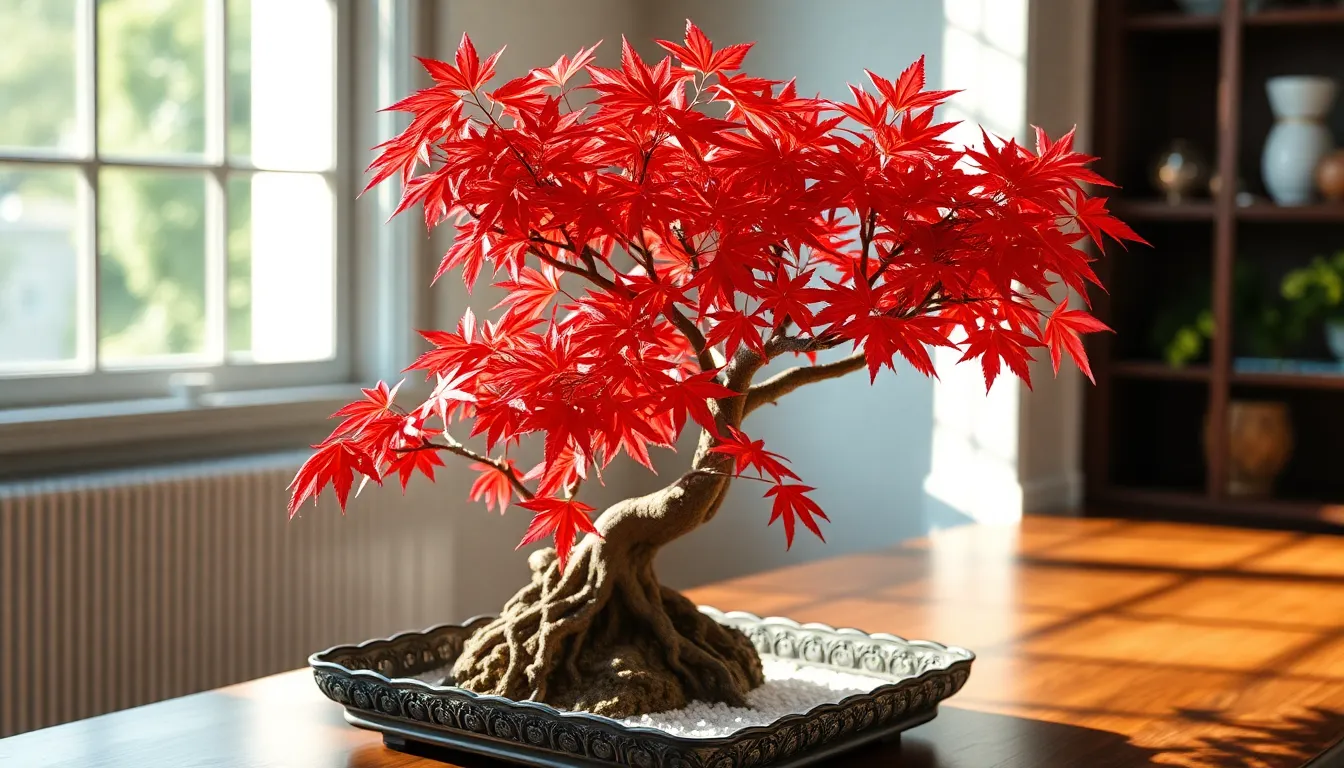
Japanese maple bonsai brings the stunning beauty of full-sized red trees into compact indoor spaces. We’ll explore how these miniature masterpieces create dramatic focal points while requiring specialized care techniques.
Indoor Bonsai Care Essentials
Placement becomes critical for Japanese maple bonsai success, requiring bright indirect light near south-facing windows. We recommend positioning your bonsai 3-4 feet from windows to prevent leaf scorch while ensuring adequate illumination for vibrant red coloration.
Watering demands daily attention since bonsai pots dry out quickly due to their shallow depth. Check soil moisture by inserting your finger into the top inch of soil, watering thoroughly when it feels dry to the touch.
Humidity levels between 40-60% support healthy leaf development and prevent crispy edges on delicate red foliage. Place your bonsai on humidity trays filled with pebbles and water, or use a room humidifier during dry winter months.
Pruning maintains the miniature tree’s shape while encouraging dense branching that showcases more red leaves. Trim new growth to 2-3 leaf pairs using sharp bonsai scissors, focusing on maintaining the tree’s overall silhouette.
Fertilization requires diluted liquid fertilizer every 2-3 weeks during spring and summer growing seasons. We suggest using balanced 10-10-10 fertilizer at quarter strength to avoid burning the sensitive root system confined in small containers.
Seasonal Color Changes
Spring emergence brings fresh green leaves that gradually develop red edges as temperatures fluctuate between day and night. These initial color changes signal the beginning of your bonsai’s most dramatic transformation period.
Summer heat intensifies red pigmentation in leaves, especially when plants experience slight stress from controlled watering. We’ve observed that Japanese maple bonsai maintained at consistent temperatures between 65-70°F develop deeper red hues throughout their foliage.
Autumn delivers the most spectacular display as chlorophyll breaks down and anthocyanin pigments dominate leaf coloration. Cooler nighttime temperatures below 50°F trigger this process, creating brilliant scarlet and crimson tones that rival their full-sized counterparts.
Winter preparation involves protecting your bonsai from temperature extremes while maintaining dormancy requirements. Move plants to unheated rooms or garages where temperatures stay between 32-45°F, allowing natural seasonal cycles to continue.
Fittonia: The Nerve Plant with Red Veins
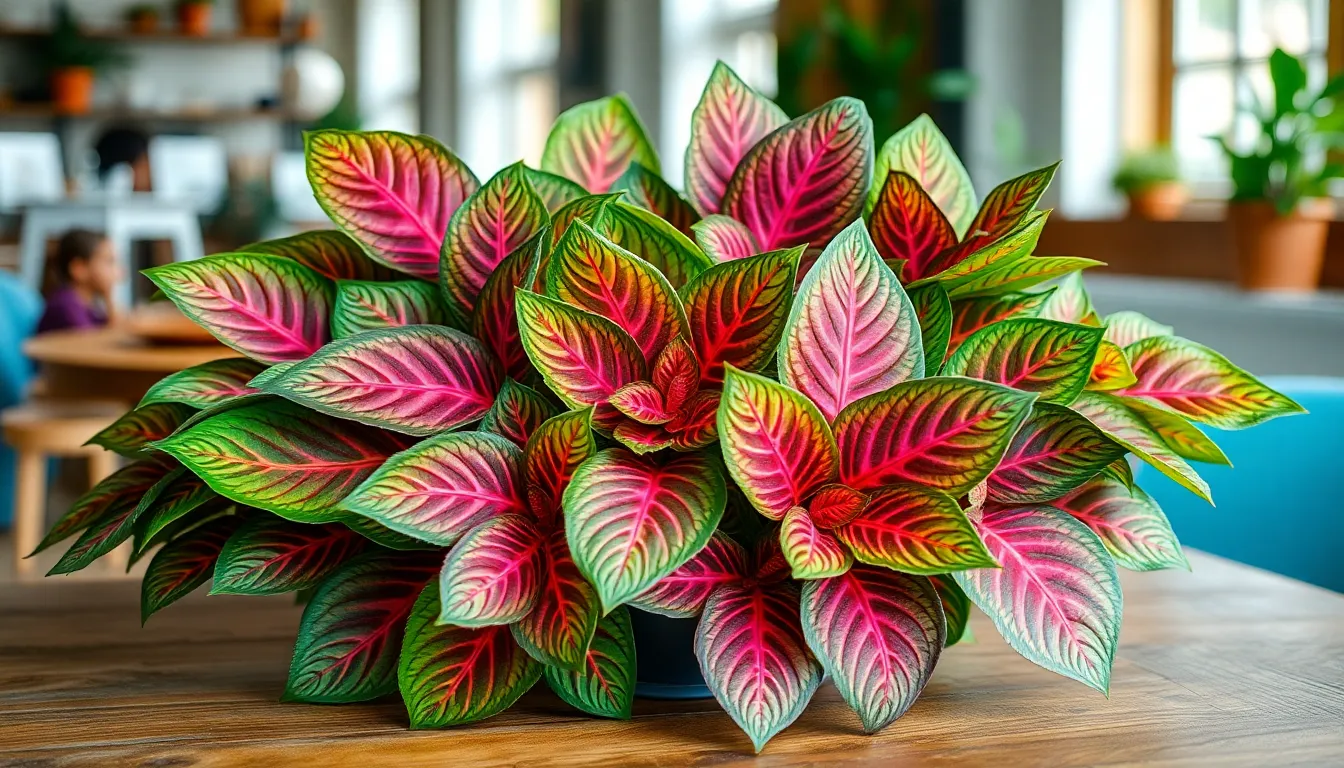
Fittonia albivenis stands out among red-leafed houseplants for its distinctive network of colorful veining that creates intricate patterns across its foliage. Popular varieties like ‘Red Anne’ and ‘Pearcei’ showcase vibrant red veins against green leaves, making them perfect accent plants for indoor collections.
Creating the Perfect Humid Environment
Maintaining proper humidity levels is essential for Fittonia’s health and vibrant coloration. We recommend keeping humidity between 40-50% to ensure the red veining remains bright and the leaves stay healthy.
Several effective methods can help us achieve optimal moisture levels:
- Humidifiers provide consistent moisture control and work best in larger rooms
- Pebble trays filled with water create localized humidity when plants sit above the water line
- Plant grouping naturally increases moisture as plants release water through transpiration
- Bathroom placement takes advantage of naturally higher humidity from showers and baths
Regular misting can supplement these methods, but we should avoid overwatering the soil to prevent root rot. Monitoring humidity with a hygrometer helps us maintain the perfect environment for our Fittonia’s striking red veined appearance.
Companion Planting Ideas
Strategic plant combinations enhance the visual impact of Fittonia’s red veining while creating cohesive indoor displays. Pairing nerve plants with complementary species creates stunning arrangements that highlight each plant’s unique characteristics.
Effective companion combinations include:
- Coleus and Fittonia create vibrant red themed groupings with varying leaf textures and patterns
- Begonia ‘Red Kiss’ with nerve plants offers contrasting leaf shapes while maintaining the red color scheme
- Philodendron ‘Imperial Red’ alongside Fittonia provides height variation and unified coloring
- Small ferns with nerve plants add green contrast that makes red veining more prominent
We find that placing taller red leafed plants like Philodendrons in back positions allows shorter Fittonia varieties to shine in foreground spots. Grouping plants with similar humidity requirements also simplifies care routines while creating visually appealing arrangements that showcase the intricate beauty of red veined foliage.
Red Prayer Plant: Moving Foliage Wonder

The Red Prayer Plant, commonly known as Maranta, stands out among red-leafed houseplants for its unique ability to fold its leaves at night. This fascinating plant combines striking red-veined foliage with an extraordinary movement pattern that captivates plant enthusiasts worldwide.
Understanding Nyctinasty and Leaf Movement
Nyctinasty represents the remarkable phenomenon where plant parts respond to darkness and light cycles through distinctive movements. Prayer plants demonstrate this behavior most dramatically as their leaves fold upwards during nighttime hours and return to their normal horizontal position when daylight arrives.
This natural movement occurs due to specialized cells called pulvini located at the base of each leaf. These cells contain varying water pressures that change throughout the day, causing the leaves to shift position in response to circadian rhythms. Scientists believe this adaptation helps plants conserve moisture and protect their leaf surfaces from potential nighttime damage.
The folding motion typically begins around dusk and continues throughout the night, creating an almost prayer-like appearance that gives the plant its common name. Morning light triggers the reverse process, with leaves gradually opening to their daytime position over several hours. This daily routine continues regardless of artificial lighting conditions, demonstrating the plant’s strong internal biological clock.
Troubleshooting Common Problems
Overwatering poses the most important threat to prayer plants, often leading to root rot that can quickly kill these moisture-sensitive plants. We recommend checking soil moisture by inserting your finger about an inch deep into the potting mix before watering. The soil should feel slightly damp but never soggy or waterlogged.
Insufficient light frequently causes prayer plants to lose their vibrant red vein coloration and may disrupt their natural nyctinastic movements. These plants thrive in bright, indirect light conditions but struggle in both direct sunlight and deep shade. Place your prayer plant near an east or north-facing window for optimal light exposure without harmful direct rays.
Low humidity creates brown leaf edges and stunted growth in prayer plants, which naturally prefer humidity levels between 50-60%. Create a humid microenvironment by placing a water-filled pebble tray beneath the plant pot or grouping it with other humidity-loving plants. Regular misting can supplement humidity but avoid spraying water directly onto the leaves to prevent fungal issues.
Temperature fluctuations stress prayer plants and may cause their distinctive leaf movements to become erratic or stop entirely. Maintain consistent temperatures between 65-75°F and protect plants from cold drafts, heating vents, and sudden temperature changes. Regular fertilization with a balanced, diluted houseplant fertilizer during the growing season helps maintain both leaf health and vibrant coloration.
Poinsettia: Beyond Holiday Decorations
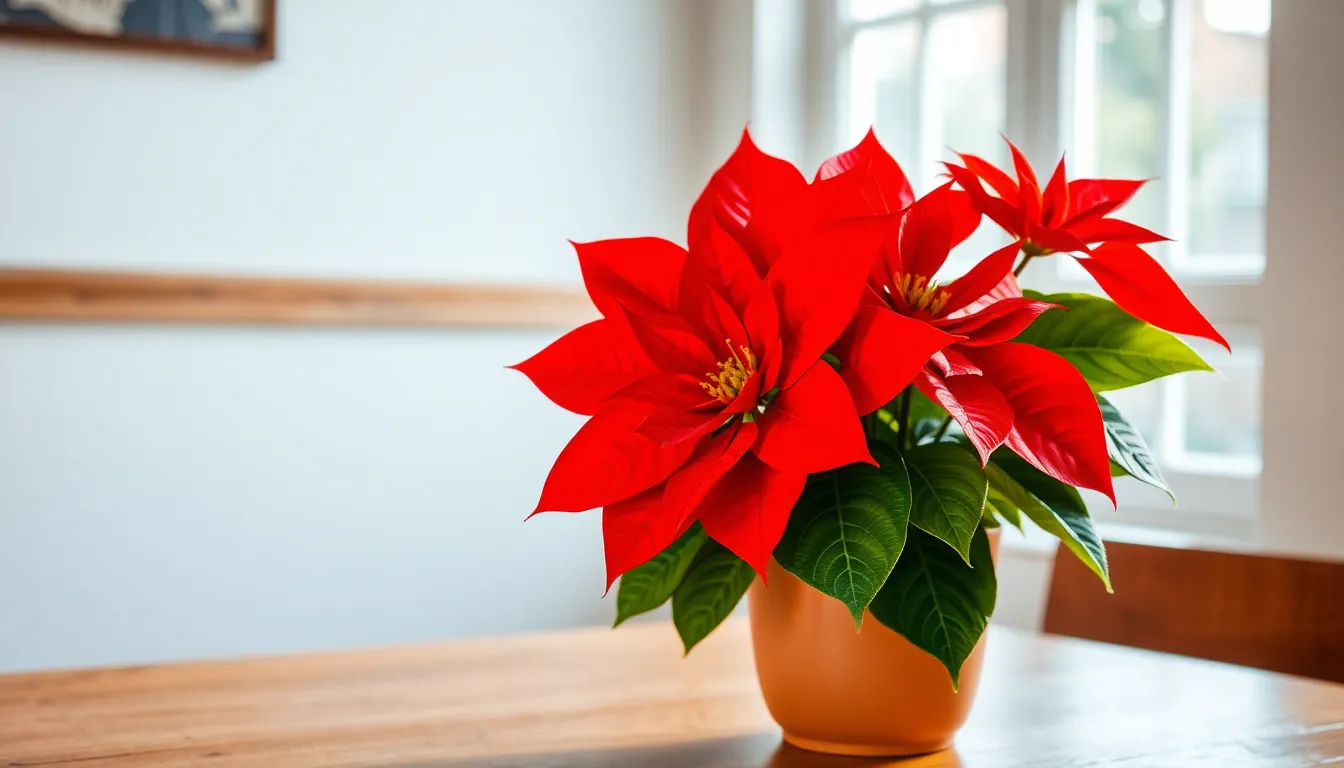
We often forget that poinsettias can thrive as year-round houseplants with their stunning red foliage adding warmth to our homes well beyond the holiday season.
Year-Round Care for Lasting Beauty
Maintaining poinsettias throughout the year requires consistent attention to their exact environmental needs. We recommend placing these plants in locations that receive bright, indirect light while avoiding prolonged exposure to direct sunlight that can cause the vibrant red bracts to fade. Temperature control plays a crucial role in their success, with optimal conditions ranging between 65°F and 70°F to sustain their brilliant coloration and overall health.
Watering practices should remain moderate and consistent, allowing the soil to dry slightly between waterings to prevent root rot. Overwatering poses the greatest threat to poinsettia health, so we suggest checking soil moisture regularly before adding water. Humidity levels around 40-50% help maintain the plant’s glossy appearance and prevent leaf drop, which often occurs in dry indoor environments.
Regular feeding during the growing season supports robust growth and color intensity. We use a balanced, water-soluble fertilizer every two weeks during spring and summer months when the plant actively produces new growth. Pruning spent flowers and leggy stems encourages bushier development and helps maintain an attractive, compact shape throughout the year.
Encouraging Red Bract Development
Developing those signature red bracts requires exact environmental manipulation that mimics natural seasonal changes. We create optimal conditions by providing approximately 14 hours of complete darkness daily for 8-10 weeks starting in early fall, which triggers the plant’s natural blooming cycle. During daylight hours, bright, indirect light exposure helps maintain healthy foliage while supporting bract formation.
Temperature fluctuations between day and night enhance color development, with cooler evening temperatures around 60-65°F promoting more intense red pigmentation. Avoiding temperatures above 70°F prevents color fading and maintains the deep, rich hues that make poinsettias so desirable. Consistent environmental conditions during this critical period ensure successful bract transformation from green to vibrant red.
Nutrition management becomes essential during bract development, requiring reduced fertilization to prevent excessive leaf growth that competes with color formation. We stop regular feeding about six weeks before the desired blooming period, allowing the plant to focus energy on developing those spectacular red bracts rather than producing new foliage.
Essential Care Tips for All Red-Leafed Houseplants
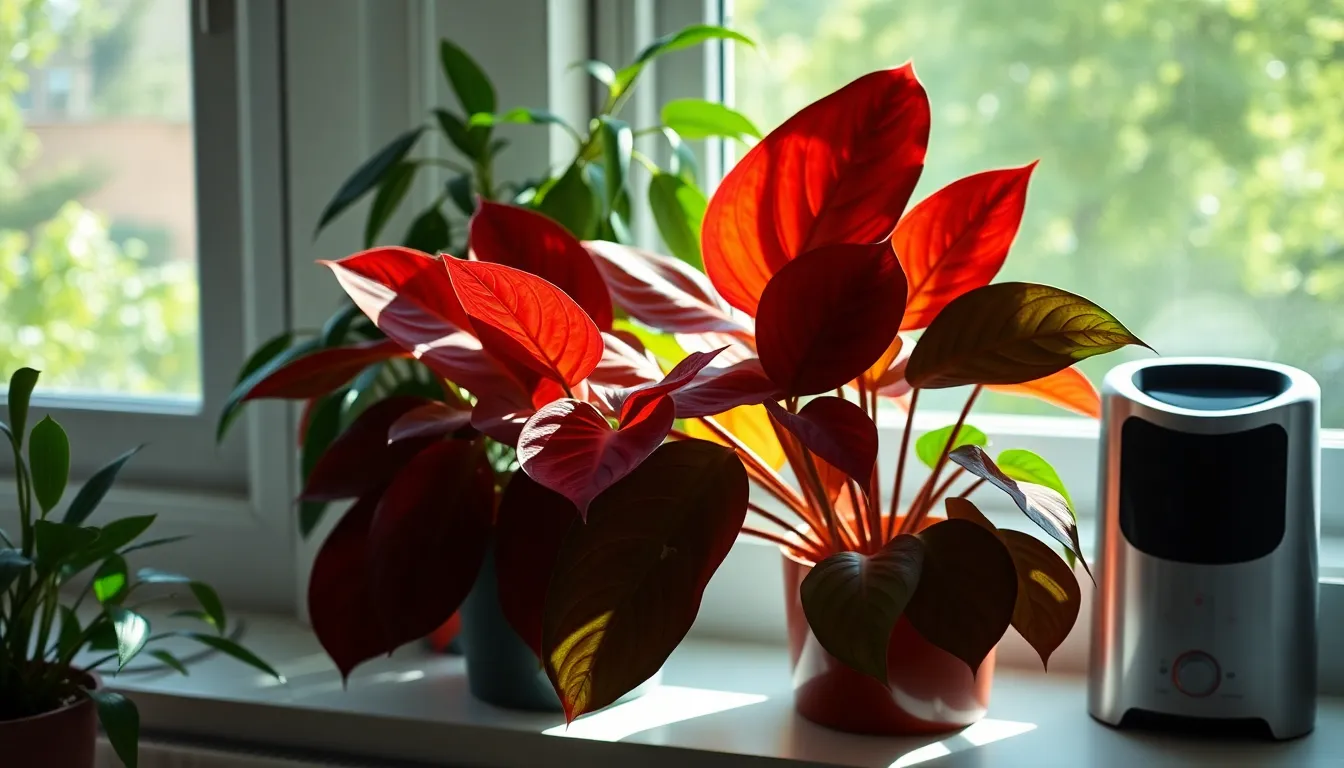
We’ve covered the most stunning red-leafed varieties available. Now let’s explore the fundamental care principles that’ll keep your red foliage vibrant and healthy.
Light Requirements and Placement
Bright, indirect sunlight serves as the foundation for healthy red-leafed houseplants. Most red-leafed varieties thrive when positioned near east or west-facing windows where they receive optimal light exposure without harsh direct rays. Direct hot sun can cause leaf burn and fade the vibrant red pigmentation we’re trying to preserve.
Insufficient light poses an equally serious threat to red foliage. We recommend avoiding dark corners entirely, as poor lighting conditions dull leaf color and stunt overall growth. Plants placed in inadequate light often lose their striking red hues and develop pale, lackluster foliage.
Supplemental lighting becomes essential during winter months. Grow lights can bridge the gap when natural daylight decreases, ensuring your red-leafed plants maintain their brilliant coloration year-round. Position grow lights 12-18 inches above the plants for optimal results.
Watering and Humidity Management
Proper watering technique starts with the soil touch test. We water when the top inch of soil feels dry to the touch for smaller plants, or the top two inches for larger specimens. This method prevents both overwatering and underwatering, which can compromise the plant’s health.
Well-draining soil and proper drainage prevent root rot disasters. Every pot must have drainage holes to allow excess water to escape. We use well-draining potting mixes specifically designed for houseplants, avoiding heavy garden soil that retains too much moisture.
Higher humidity levels enhance red leaf coloration and overall plant health. Red-leafed houseplants benefit from humidity levels between 40-60%, which we achieve through regular misting, humidifiers, or pebble trays filled with water. Strategic placement away from heating and cooling vents prevents sudden humidity drops.
| Care Aspect | Details |
|---|---|
| Light | Bright, indirect sunlight; avoid direct sun and deep shade |
| Watering | Water when top soil is dry; ensure good drainage |
| Humidity | Moderate to high; mist leaves or use humidifier |
| Placement | Near east or west windows; avoid cold drafts and vents |
| Soil | Well-draining mix; pot with drainage holes |
Consistent care routines maintain vibrant foliage across all red-leafed varieties. Popular species like Philodendron Imperial Red, Anthuriums, and Caladiums respond exceptionally well to these fundamental care principles, rewarding us with stunning red displays when their needs are met.
Conclusion
Red-leafed houseplants offer an incredible opportunity to transform our living spaces with bold color and natural beauty. These stunning varieties bring warmth and energy to any room while serving as eye-catching focal points that spark conversation.
We’ve explored many options from the versatile Coleus to the dramatic Japanese Maple Bonsai each offering unique characteristics and care requirements. Whether we’re beginners looking for low-maintenance options like Red Aglaonema or experienced gardeners ready to tackle specialized care for Caladiums these plants provide endless possibilities for indoor gardening success.
The key to thriving red foliage lies in understanding each plant’s exact needs particularly lighting humidity and temperature requirements. With proper care and attention these remarkable plants will reward us with vibrant coloration that enhances our homes throughout the year.
Start your red-leafed houseplant journey today and discover how these botanical gems can elevate your indoor environment with their stunning natural artistry.
Frequently Asked Questions
What are red-leafed houseplants and why are they popular?
Red-leafed houseplants are indoor plants that feature vibrant red foliage, adding striking color and personality to living spaces. They’re popular because they serve as both decorative elements and conversation starters, creating dramatic focal points in modern minimalist homes while stimulating energy and warmth in indoor environments.
What causes the red coloration in houseplant leaves?
The red coloration comes from pigments called anthocyanins that develop under specific environmental conditions. These pigments respond to certain light spectrums and temperature fluctuations, with many varieties intensifying their red hues during cooler months or with adequate light exposure.
Which red-leafed houseplants are best for beginners?
Red Aglaonema is ideal for beginners as it’s reliable and easy to care for. Coleus varieties like ‘Redhead’ and ‘Wizard Red’ are also excellent choices, requiring only bright indirect light and consistent watering. These plants are forgiving and adapt well to indoor conditions.
How much light do red-leafed houseplants need?
Most red-leafed houseplants thrive in bright, indirect sunlight. Place them near east or west-facing windows while avoiding direct sun that can scorch leaves. Adequate light is crucial for maintaining vibrant red coloration—insufficient light causes colors to fade and become dull.
What are the watering requirements for red-leafed plants?
Use well-draining soil and water consistently but avoid overwatering, which can cause root rot. Allow the top inch of soil to dry between waterings. Most red-leafed plants prefer moderate moisture levels and benefit from consistent watering schedules rather than sporadic heavy watering.
How important is humidity for red-leafed houseplants?
Humidity is crucial for most red-leafed plants, with optimal levels between 40-60%. Maintain humidity using humidifiers, pebble trays, or grouping plants together. Plants like Fittonia and Red Prayer Plant especially require consistent humidity to prevent leaf browning and maintain vibrant colors.
What temperature range is best for red-leafed houseplants?
Most red-leafed houseplants prefer temperatures between 65-75°F (18-24°C). Avoid placing them near heating vents, air conditioners, or drafty windows. Consistent temperatures help maintain leaf coloration, while temperature fluctuations can stress plants and affect their vibrant red hues.
How often should I fertilize red-leafed houseplants?
Feed red-leafed plants with balanced fertilizer during the growing season (spring and summer) to support vibrant coloration. Most varieties benefit from monthly fertilization, but reduce or stop feeding during winter dormancy. Over-fertilization can damage roots and affect leaf color intensity.
Do red-leafed houseplants need special pruning?
Regular pruning encourages bushier growth and maintains plant shape. Remove dead, damaged, or yellowing leaves promptly. For plants like Coleus and Croton, pinch growing tips to promote branching. Prune during active growing seasons for best results and healthier plant development.
Can red-leafed houseplants be propagated at home?
Yes, many red-leafed plants can be propagated through stem cuttings or division. Red Aglaonema propagates well through stem cuttings in water or soil. Coleus roots easily from cuttings, while plants like Caladium can be divided during repotting for new plants.
